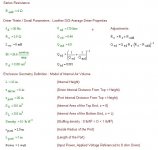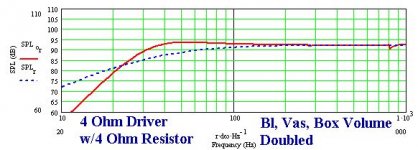Amit:
Thank you for the correction-the speaker itself doesn't even get a full watt when you add the 4 ohm resistor-it goes down 0.5 watt.
Just to review:
A 2.8 Volt signal is used to test sensitivity of speakers these days. That is because at 2.8 Volts, an 8 ohm speaker will draw one watt of power, so it is the equivalent of testing at one watt-if you use an 8 ohm speaker.
However, many speakers these days are 4 ohms. At 2.8 Volts, a 4 ohm speaker draws 2 watts, so it's sensitivity rating is higher.
When we add the 4 ohm resistor to the 4 ohm speaker, we do two things:
A) We increase the ohmage of the load the amp is driving, so only one watt total is dropped across the 4 ohm speaker plus 4 ohm resistor load together.
B) The 4 ohm reistor is going to use up half that watt, so the speaker only gets the remaining half.
So when the 4 ohm resistor is added, the speaker goes from getting 2 watts before the resistor is added to getting one half watt after it is added.
Again-thanks for the correction.
Thank you for the correction-the speaker itself doesn't even get a full watt when you add the 4 ohm resistor-it goes down 0.5 watt.
Just to review:
A 2.8 Volt signal is used to test sensitivity of speakers these days. That is because at 2.8 Volts, an 8 ohm speaker will draw one watt of power, so it is the equivalent of testing at one watt-if you use an 8 ohm speaker.
However, many speakers these days are 4 ohms. At 2.8 Volts, a 4 ohm speaker draws 2 watts, so it's sensitivity rating is higher.
When we add the 4 ohm resistor to the 4 ohm speaker, we do two things:
A) We increase the ohmage of the load the amp is driving, so only one watt total is dropped across the 4 ohm speaker plus 4 ohm resistor load together.
B) The 4 ohm reistor is going to use up half that watt, so the speaker only gets the remaining half.
So when the 4 ohm resistor is added, the speaker goes from getting 2 watts before the resistor is added to getting one half watt after it is added.
Again-thanks for the correction.
kelticwizard my original response was based on voltage dividers and how much power goes to the speaker and the resistor.The power rating should be about half of what the amp can deliver.
What I would like to know, is how a series resistor affects Qes when two drivers wired in series do not. Two identical drivers will have almost identical impedance at every frequency (or just DCR) and therefore it is like having a resistor in series. Why is Qes not affected here?
It is but the Qm is also doubled (or halved, can't remember which) which equals it out completely resulting in the same Qt.
nunayafb said:
kelticwizard my original response was based on voltage dividers and how much power goes to the speaker and the resistor.
What I would like to know, is how a series resistor affects Qes when two drivers wired in series do not. Two identical drivers will have almost identical impedance at every frequency (or just DCR) and therefore it is like having a resistor in series. Why is Qes not affected here?
As an amateur, I have no technical answer to your question. However, I would like to point out a couple of things which might help.
If you hook up another speaker in series, you would have another magnet in the picture to increase, (perhaps double) the Bl. And this two speaker combo would also have double the Vas requirements, double the cone area, (Sd), and would therefore require double the box volume. The duct length woulld have to be adjusted to return the box tuning to 30 Hz.
So I left the 4 ohm speaker in place but changed some things to compensate for what the second speaker would bring if it were hooked up. Here are the parameters for that same speaker with the 4 ohm resistor added, only with the Bl doubled, the Sd doubled, the Vas, (Vad) doubled and box volume doubled as well.
Attachments
And here is the frequency response after those changes. The curve seems to be returned to it's original shape before the 4 ohm resistor was added. However the SPL output at 2.8 Volts is a little lower. I would guess that is because this is now an 8 ohm speaker, and is drawing one watt instead of two at 2.8 Volts than it did when it was a 4 ohm speaker.
Attachments
nunayafb said:
kelticwizard my original response was based on voltage dividers
and how much power goes to the speaker and the resistor.
What I would like to know, is how a series resistor affects Qes
when two drivers wired in series do not. Two identical drivers will
have almost identical impedance at every frequency (or just DCR)
and therefore it is like having a resistor in series.
Why is Qes not affected here?
Hi,
Qes depends on Re. When you add a 4R resistor Re goes up.
Two drivers with two magnetic circuits the seperate Re's remain
the same effectively, it is not the same as the resistive case.
🙂/sreten.
Qes depends on Re. When you add a 4R resistor Re goes up.
that part I understand
Two drivers with two magnetic circuits the seperate Re's remain the same effectively, it is not the same as the resistive case.
I think you left out a word or a comma here, what I think you are trying to say that two drivers wont interact because of the separate magnetic circuits? Even though dcr is always present?
I am not trying to be difficult or argumentative wrt the effect of Rseries on Qes, I now believe that is the case. What still is unclear is how a resistor can have a profound effect on a driver but the resistance and or impedance of an electro-mechanical resistor (speaker) does not. Referencing Kelticwizards statements about sd, vas and bl, none of those parameters affect Re except maybe bl, because you are doubling the dcr of the series speaker arrangement, ie you are adding a resistor.
If any of you could suggest where I might look to learn more about this, I have a circuits book from college just don't know what "section" it falls under. I kind of feel like I am pushing you guys to teach me this stuff and I don't want to do that, but the logical portion of my brain has thrown up a red flag:
Why does one type of resistance affect Qes but not another type?
Hi,
Another way of looking at Qes is the amount of current allowed
to flow in in the cirtcuit when the cone moves. Obviously open
circuit there is no Qes. Short circuit is the usual case, that is :
being driven by a voltage amplifier with near zero impedance.
Adding any resistance lowers Qes by impeding current.
If you consider the series / parallel cases and the current induced
in each coil you should be able to see that nothing changes from
the single driver case except the power per driver.
Parrallel I think it should be obvious its the same, as is the power.
Series you do have double the Re but also two motors which will
produce twice the back emf balancing the increase in loop R.
FWIW Re and external R are not theoretically different.
Say a VC coil has Re = 4 ohms. If you made it exactly the same but
with "super" wire such that Re = 1 ohm Qes will change. Only with
an external 3R resistor would the Qes be the same.
🙂/sreten.
Another way of looking at Qes is the amount of current allowed
to flow in in the cirtcuit when the cone moves. Obviously open
circuit there is no Qes. Short circuit is the usual case, that is :
being driven by a voltage amplifier with near zero impedance.
Adding any resistance lowers Qes by impeding current.
If you consider the series / parallel cases and the current induced
in each coil you should be able to see that nothing changes from
the single driver case except the power per driver.
Parrallel I think it should be obvious its the same, as is the power.
Series you do have double the Re but also two motors which will
produce twice the back emf balancing the increase in loop R.
FWIW Re and external R are not theoretically different.
Say a VC coil has Re = 4 ohms. If you made it exactly the same but
with "super" wire such that Re = 1 ohm Qes will change. Only with
an external 3R resistor would the Qes be the same.
🙂/sreten.
- Status
- Not open for further replies.
- Home
- Loudspeakers
- Subwoofers
- Powering Subwoofer

